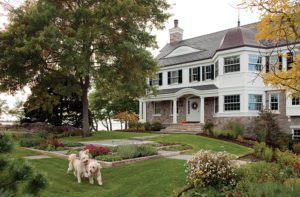Chip Webster
June 15, 2011
Photography by Michael Partenio
This summer will see the reopening of Greater Light, former home and studio of two prominent figures in the summer colony of artists that thrived on Nantucket in the 1920s. Philadelphia sisters Hanna and Gertrude Monoghan were guided by their Quaker beliefs in creating a quirky, character-filled workspace and dwelling; local architect Chip Webster has now been instrumental in the Nantucket Historical Association’s project to restore their remarkable summer home.
Kyle Hoepner: Chip, can you give us a brief history of the Monaghan sisters and Greater Light?
Chip Webster: The original structure was a barn built in 1791 for livestock. It was a “bank barn,” where one entered the upper level from the street to the west and entered the lower level from down in the area that is now the garden. The lower level was used predominantly as a livestock space, with a pigsty and stalls.
In 1906, the town grocer, William Holland, purchased the barn and used it to house cows, pigs and horses. It was an unusual structure for the neighborhood, as it was a working barn, filled with farm animals, surrounded by larger “white-columned” houses.
In 1929, Hanna and Gertrude Monoghan were visiting the island with their family. The sisters were artists from Philadelphia and were looking for a summer retreat. They stumbled on the barn by accident and decided they wanted to purchase it and convert it into a summer home. When they first approached Mr. Holland, he refused to sell, explaining that many people had offered to purchase the barn with the intent of tearing it down, because of the smell of the pigs. When the sisters replied that they had no intent to tear down the barn, Mr. Holland agreed to sell. The conversion was completed in 1933, and it is an early example of a summer home on the island, although the sisters eventually moved to Nantucket permanently.
This change proved to be controversial in the neighborhood, and the sisters later told stories of neighbors shunning—and reportedly even harassing—them for some time after the house was reconstructed. The truly unique characteristic of the house is that in some senses the sisters “assembled” it; with an artistic and decorative flair they incorporated many “found” objects into the house, including decorative wood columns, all of the ironwork, and, most significantly, the twelve-foot wrought-iron gates. Many of the pieces and furnishings in the house came from auctions, demolition sites and junkyards throughout New England.
KH: How did you get involved with the NHA’s project to renovate the building and gardens?
CW: Our firm originally became involved with the project in 2001, when the former director of the NHA asked us to do two feasibility studies on the restoration of this property and the 1800 House. We composed these studies to provide several conceptual ideas, along with budgeting and schedules for each of the options. The NHA used the studies in their long-term planning and approached us again in 2008 to begin design work on the restoration.
KH: Were the sisters’ connections to Nantucket’s history as a summer artists’ colony important to the project? And what about their Quaker faith?
CW: Yes, both factors were influential in the Monaghans’ move to Nantucket. Their artistic background was key to the architectural detailing of the property and the many gatherings they hosted there. They believed that the barn, the architectural elements and the objects they filled the house with were discovered with God’s guidance. The name Greater Light comes from the biblical verse Genesis 1:16, in which God made two great lights: the Greater Light to govern the day and the Lesser Light to govern the night. Hanna and Gertrude later purchased the house next door for their parents and named it Lesser Light.
KH: Does the project have any particularly personal connection with your own life and career on Nantucket?
CW: Absolutely. My grandparents lived one block away from Greater Light, and I spent every summer of my childhood playing in and exploring this neighborhood. Working on this project has caused a number of déjà vu experiences.
KH: What kind of shape was the building in when you started? Were there specific challenges to the renovation, related to the site or the historic status of the building?
CW: The NHA acquired the property after Hanna Monaghan passed away in the mid-1970s. For a time, they used the house as a museum space. In the mid 1990s, the building was closed to the public due to safety issues.
When we started the renovation, the existing building had been vacant for approximately ten years and was in significant disrepair. The roof had been reconstructed to prevent water damage, but there was evidence of previous water damage and vandalism. Additionally, many of the interior finishes had been stripped away to do stabilization repairs. Although the sisters incorporated the original 1791 timberframe in the house, they had modified it and removed some of the structural members. Therefore, over time, the roof developed a significant dip in the center, pushing the front wall to slope outward toward the street. This characteristic has remained, although the roof required extensive restructuring to stabilize the frame of the building.
KH: How will the completed building integrate into the public life of the island?
CW: The NHA will use Greater Light as a venue for the arts, much as the Monaghan sisters did. It will provide the association with a building that represents the early 20th century, when the artists’ colony and vacation tourism became the lifeblood of the Nantucket economy.
KH: Who else was involved in the renovation? Were there other designers or craftspeople of particular note?
CW: I worked closely on this project with my former associate Steven Blashfield, who is now at Glave and Holmes Architecture in Richmond, Va. Ethan Griffin from our office has been the lead interface on the project since Steven moved away from the island. It has also been a delight working with the NHA’s director of properties, Mark Avery.
The NHA hired local craftsman and contractor Twig Perkins to complete the restoration work on the property. John Wathe provided structural engineering services, Mary Laccoursier is the decorative painter and Jason Sullivan is handling the landscaping.
KH: What was the most fun or rewarding thing about working on Greater Light?
CW: The opportunity to work on Greater Light has been extremely rewarding because it is a structure that is completely unique, as well as being an important part of the artistic and social history of the island. Also, it is a building that would be impossible to recreate today, given current regulations and requirements. It’s fun to imagine the stimulating events that the building has accommodated over the years; I look forward to the events planned for the reopening this summer.
KH: Is there anything else related to the project that particularly intrigued you?
CW: I think the single most interesting thing about this project and this property is the unique, eclectic nature of the sisters’ architectural design. The design reflects both their Quaker frugality, using inexpensive materials such as homasote to clad large portions of the interior walls, and their artistic flair, using decorative painting and found objects to give the house a one-of-a-kind character. Using found objects in such an integrated way is not common, particularly in a house this old. In essence, this house is the very epitome of the mission of the Nantucket Historic Association, which began preserving building elements and forms before preservation was really a mainstream concept in America.
Editor’s Note The restored Greater Light will be unveiled to the public on July 20, 2011, with an open house from 2:00–5:00 p.m. There will also be open house tours all summer on Wednesdays and Fridays from 4:00–5:00 p.m. For more information about these and other events that are planned, contact the Nantucket Historical Association at (508) 228-1894 or www.nha.org.
Share
![NEH-Logo_Black[1] NEH-Logo_Black[1]](https://www.nehomemag.com/wp-content/uploads/2022/08/NEH-Logo_Black1-300x162.jpg)







